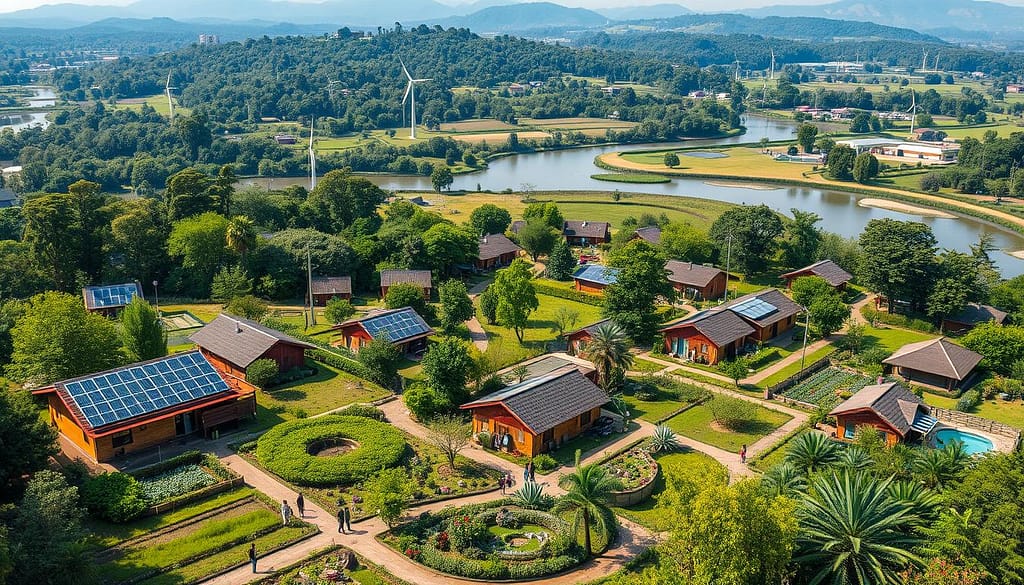Sustainable Living Communities: The Eco-Friendly Future of Urban Living
As cities continue to grow and face the challenges of overcrowding and pollution, sustainable living communities and ecovillages have emerged as transformative solutions. These eco-friendly havens offer a fresh approach to urban life, blending sustainable practices with community-centered living. In this article, we’ll explore how sustainable living communities are revolutionizing city life and paving the way for a greener future.

The Rise of Sustainable Living Communities
Sustainable living communities and ecovillages have gained significant traction in recent years. As of 2024, the Global Ecovillage Network (GEN) connects over 15,000 ecovillages and sustainable communities across 120 countries. These communities are designed to address urban challenges head-on, providing a blueprint for reducing pollution, fostering tight-knit neighborhoods, and promoting sustainable living practices.
Key Principles of Sustainable Living
Sustainable living communities and ecovillages adhere to several core principles:
- Ecological Harmony: Integrating with the natural environment and minimizing ecological impact.
- Social Sustainability: Fostering a strong sense of community and social cohesion.
- Economic Viability: Supporting local economies and promoting self-sufficiency.
- Cultural Diversity: Celebrating and preserving cultural heritage and traditions.
By embracing these principles, sustainable living communities demonstrate that it is possible to live in harmony with nature while maintaining a high quality of life.
Addressing Urban Overcrowding
One of the primary challenges facing cities today is urban overcrowding. As of 2024, over 60% of the world’s population resides in urban areas, putting immense pressure on housing, infrastructure, and resources. Sustainable living communities offer innovative solutions to this problem through space optimization and efficient design.
How Do Sustainable Living Communities Address Overcrowding?
- Co-housing Models: Shared living spaces that reduce individual housing demands.
- Shared Common Areas: Spaces like dining halls, gardens, and recreational areas are shared among residents.
- Compact Living Spaces: Smaller, well-designed homes that optimize space usage.
These strategies reduce the need for large individual living spaces, allowing communities to accommodate more residents while maintaining a high quality of life. Additionally, sustainable infrastructure, such as vertical gardens, rooftop solar panels, and efficient transportation systems, further optimize space and resources.
Combating Pollution and Promoting Sustainability
Sustainable living communities and ecovillages are at the forefront of combating pollution and promoting sustainable practices. These communities prioritize energy efficiency, renewable energy sources, and waste reduction strategies to minimize their environmental impact.
How Do Sustainable Living Communities Reduce Pollution?
- Energy-Efficient Buildings: Construction of homes with better insulation and reduced energy consumption.
- Sustainable Transportation Options: Use of electric vehicles, bicycles, and pedestrian-friendly pathways.
- Renewable Energy Systems: Use of solar, wind, and hydropower to reduce reliance on fossil fuels.
Ecovillages have achieved remarkable success in reducing carbon footprints, with an average reduction of 70-85% compared to traditional urban communities. By embracing green technologies and practices, sustainable living communities demonstrate that it is possible to significantly reduce pollution and carbon emissions in urban settings.

The Role of Waste Reduction in Sustainable Living Communities
Waste reduction is a key aspect of sustainable living. Ecovillages and sustainable communities have contributed to a 25% reduction in global waste production since 2021. This is achieved through the implementation of comprehensive waste management strategies, including:
- Composting: Turning organic waste into nutrient-rich soil for gardening.
- Recycling: Encouraging residents to recycle materials like paper, glass, and plastics.
- Circular Economy Practices: Reusing and repurposing materials to reduce waste.
By minimizing waste and promoting resource efficiency, these communities set a powerful example for cities around the world.
The Power of Green Spaces and Biodiversity
Sustainable living communities recognize the importance of green spaces and biodiversity in creating healthy, vibrant urban environments. These communities prioritize the integration of nature into the built environment, creating thriving ecosystems within city limits.
How Do Green Spaces Improve Urban Living?
- Community Gardens and Urban Farms: Providing fresh, locally grown produce for residents.
- Green Corridors: Connecting natural habitats to support biodiversity and wildlife.
- Reduction of Urban Heat Island Effect: Green spaces cool urban areas, reducing the “heat island” effect.
These green spaces not only enhance the aesthetic appeal of the community but also offer numerous benefits, such as reducing urban heat island effects, improving air quality, and promoting mental well-being.
Case Studies: Successful Sustainable Living Communities
Several ecovillages and sustainable communities have demonstrated the viability and success of this urban living model. Here are two noteworthy examples:
1. BedZED (Beddington Zero Energy Development), UK
BedZED is a pioneering sustainable community that showcases the potential of eco-friendly urban living. Notable features include:
- Energy-Efficient Homes: Homes that consume 60% less energy than conventional communities.
- Green Roofs: Spaces for biodiversity, insulation, and reduced stormwater runoff.
- Car-Free Environment: Promoting cycling, walking, and public transport over car usage.
Key Impact: BedZED achieved a 60% reduction in energy consumption and a 50% reduction in water usage.
2. Hammarby Sjöstad, Sweden
Hammarby Sjöstad is a prime example of sustainable urban development. Its design incorporates:
- Closed-Loop Waste Management: Recycling waste back into resources.
- Renewable Energy Integration: Solar, wind, and district heating systems.
- Extensive Green Spaces: Creating a community with access to natural areas for residents.
Key Impact: The community achieved a 50% reduction in carbon emissions and a 60% reduction in waste sent to landfills.
These case studies demonstrate the tangible benefits and positive impact of sustainable living communities in urban settings.
Conclusion
Sustainable living communities and ecovillages offer a transformative solution to the challenges of urban overcrowding and pollution. By embracing eco-friendly practices, community-centered living, and sustainable technologies, these communities provide a blueprint for creating healthier, more resilient cities.
As we look towards the future, it is clear that sustainable living communities will play a crucial role in shaping the sustainable cities of tomorrow. By learning from the success stories of ecovillages and sustainable communities, we can work towards building a greener, more sustainable future for all.
FAQs on Sustainable Living Communities
1. What is the purpose of sustainable living communities and ecovillages?
Sustainable living communities and ecovillages aim to address urban challenges such as overcrowding and pollution by promoting eco-friendly practices, community-centered living, and sustainable technologies.
2. How do sustainable living communities combat urban overcrowding?
Sustainable living communities combat urban overcrowding through space optimization, efficient design, and the use of co-housing models and shared common areas.
3. What are the key principles of sustainable living communities?
The key principles of sustainable living communities include ecological harmony, social sustainability, economic viability, and cultural diversity.
4. How do ecovillages reduce pollution and promote sustainability?
Ecovillages reduce pollution and promote sustainability through energy efficiency, renewable energy sources, waste reduction strategies, and the integration of green spaces and biodiversity.
5. Can you provide examples of successful sustainable living communities?
Yes, BedZED in the UK and Hammarby Sjöstad in Sweden are two successful examples of sustainable living communities that have achieved significant reductions in energy consumption, water usage, carbon emissions, and waste production.
